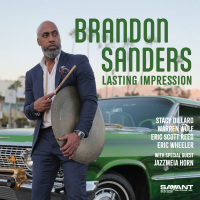Home » History of Jazz Timeline: 1956
History of Jazz Timeline: 1956
 AAJ Building a Jazz Library: Masterpieces
Thelonious Monk - Brilliant Corners
Quirky yet rigorously logical, Brilliant Corners is a triumph of composition and performance, a set heavy on Monk originals with Rollins, Roach and Pettiford along for the swing. Even its title describes Monk's angular genius.
AAJ Building a Jazz Library: Masterpieces
Thelonious Monk - Brilliant Corners
Quirky yet rigorously logical, Brilliant Corners is a triumph of composition and performance, a set heavy on Monk originals with Rollins, Roach and Pettiford along for the swing. Even its title describes Monk's angular genius.
Charles Mingus records the LP Pithecanthropus Erectus. This recording demonstrates some of the earliest use of modal themes in Jazz. Mingus uses unusual saxophone cries and hollers to simulate the human voice. Newer forms of Jazz are being explored.
 AAJ Building a Jazz Library: Masterpieces
Sonny Rollins - Saxophone Colossus
Not just one of Rollins' great moments - one of the great "monster" jazz sessions of all time, and, in "St. Thomas," one the first crossroads between Jazz and the Caribbean.
AAJ Building a Jazz Library: Masterpieces
Sonny Rollins - Saxophone Colossus
Not just one of Rollins' great moments - one of the great "monster" jazz sessions of all time, and, in "St. Thomas," one the first crossroads between Jazz and the Caribbean.
Clifford Brown plays an informal gig at a Music City store in Philadelphia on June 25. Later that night Clifford Brown, Richie Powell (Bud's brother) and Richie's wife Nancy head west on the Pennsylvania Turnpike. In the early hours of June 26, their car veers off the road killing all three. It was a great loss for Jazz.
Clifford Brown's death is a great shock and a heavy blow for Sonny Rollins who idolized Brown.
Clifford Brown takes his place beside Jazz greats such as Charlie Parker and Louis Armstrong.
Detroit pianist Barry Harris replaces Richie Powell in the Max Roach quintet. Clifford was not replaceable except maybe by Lee Morgan.
Guitarist Mundell Lowe brings piano player Bill Evans to the attention of Orin Keepnews and Bill Grauer of Riverside records.
Pianist Bill Evans records New Jazz Conceptions which is available on Original Jazz Classics. This is Bill's first effort as a leader. The personnel are Bill, Teddy Kotick on bass and Paul Motian on drums.
Blue Note's Alfred Lion and Frank Woolf go to Small's Paradise in Harlem to hear a Jazz organist named Jimmy Smith. Woolf describes the scene, "It was at Small's in January of 1956. He was a stunning sight. A man in convulsions, face contorted, crouched over in apparent agony, his fingers flying, his foot dancing over the peddles. The air was filled with waves of sound I had never heard before. A few people sat around, puzzled but impressed. Jimmy came off the stand smiling...'So what do you think?' he asked. 'Yeah!' I said. That's all I could say. Alfred Lion had already made up his mind." (Woolf quote found in the Rosenthal book, page 112 - see bibliography)
Piano player Cecil Taylor records for Transition with Steve Lacy on soprano saxophone, Buell Neidlinger on bass and Dennis Charles on drums. The record which they make is not a commercial success, but musicians take notice. The music exhibits most of the devices that would later become Free Jazz.
Miles Davis and his quintet record four records for Prestige. These records are Cookin', Relaxin', Workin' and Steamin'. They take only two days to complete. Miles also records 'Round about Midnight on the Columbia label.
Miles Davis fires Coltrane for showing up to work drunk. Davis hires Sonny Rollins to replace him.
Coltrane records with pianist and composer Tadd Dameron on Mating Call (Prestige).
Eighteen-year-old trumpeter Lee Morgan from Philadelphia cuts his first records as a
leader for the Blue Note and Savoy labels.
Lee Morgan is currently with Dizzy Gillespie's big band.
Pianist Horace Silver leaves the Jazz Messengers and drummer Art Blakey becomes the leader.
Detroit pianist Tommy Flanagan moves to New York. He plays on Sonny Rollins' Saxophone Colossus (see above).
Duke Ellington's band performs at the Newport Jazz Festival. Duke's band devises a landmark performance which is capped by an amazing tenor saxophone solo by Paul Gonsalves on Diminuendo and Crescendo in Blue. Duke gets a new record contract with Columbia.
Louis Armstrong tours Great Britain.
Louis Armstrong travels to Ghana as Ambassador Satch.
Clarinetist Edmund Hall joins Armstrong's Allstars.
Dizzy Gillespie meets Argentine pianist Lalo Schifrin and is impressed. Dizzy continues to gravitate to the Latin rhythms.
Frank Trumbauer, saxophonist and major influencer of Lester Young, dies at the age of 45.
Art Tatum dies in November.
Bass saxophonist Adrian Rollini dies.
Billie Holiday is arrested for drugs again. This time she'll quit. However, she begins to drink more and becomes addicted to television.
Bud Powell makes his first appearance in Europe.
Japanese artist and composer Toshiko Akiyoshi arrives in the U.S. to attend the Berklee School of Music.
Ray Charles records yet another big hit called What'd I Say.
In Liverpool, England, an unknown teenager named John Lennon forms a group called the
Quarry Men. This group begins as a Skiffle (or Folk/Blues) group. The group will eventually
include George Harrison and Paul McCartney and will evolve into the Beatles in the early
1960s. The Beatles owed a lot to the Trad Jazz which was played in England during their
childhood and adolescence. They will eventually have their influences on Jazz also -- "the
child is father to the man."
Charles Mingus starts to greatly free up his music.
Keyword Search
Disclaimer: Though we have checked our facts, this timeline may contain erroneous information. If you discover errors or omissions, please bring them to our attention.









